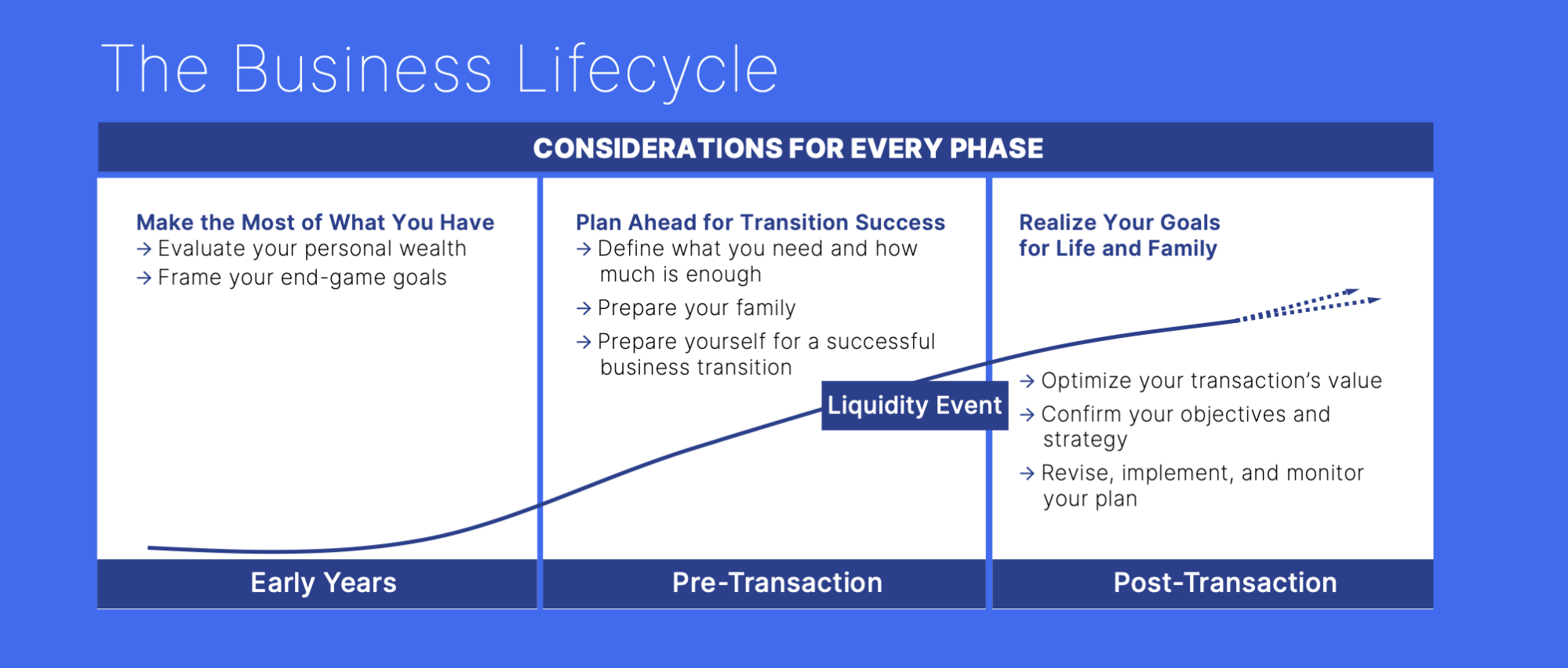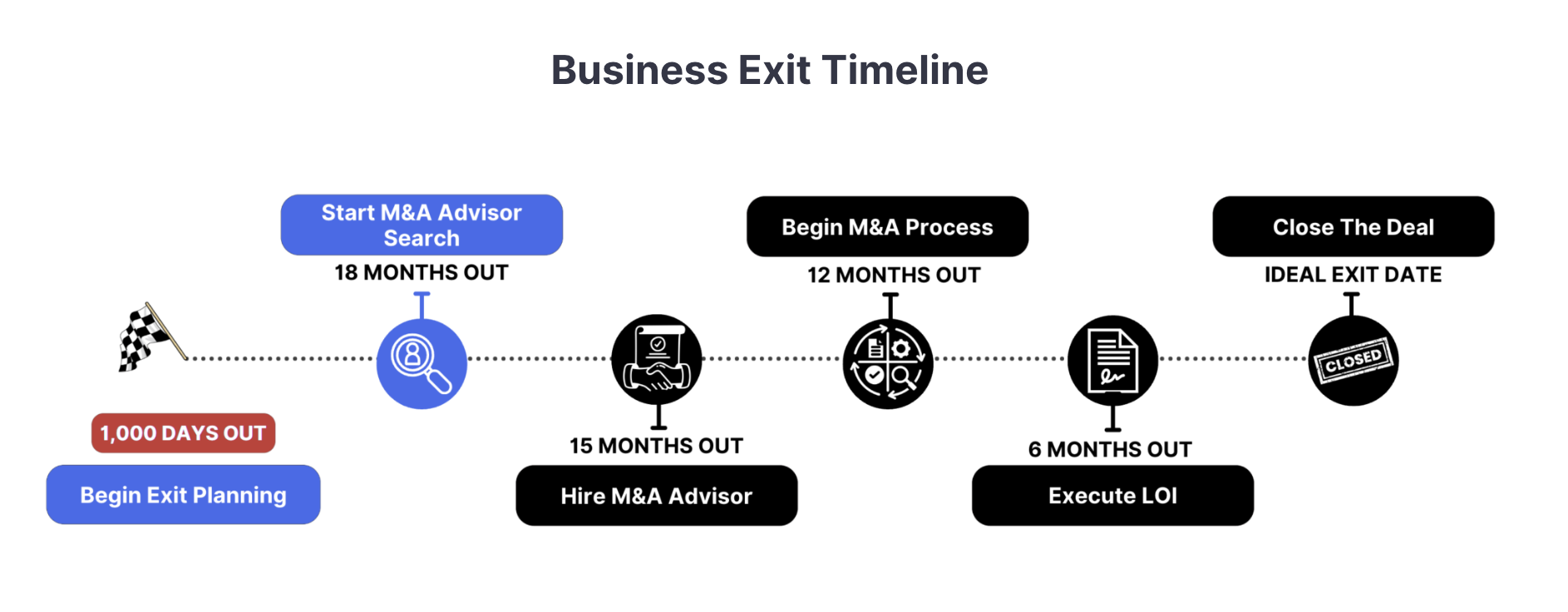
The Advisor Finder Report: Q3 2025
Welcome to the Q3 2025 issue of The Advisor Finder Report, a quarterly publication that surfaces the activity occurring on…
Building a successful business takes years of dedication, and ensuring a seamless transition that protects its value and continuity requires careful planning and foresight.
Business transition planning should be viewed as a slow, thoughtful process that begins early in your business’ growth, not as something to start right before selling.
At Axial, we breakdown business transition planning in three phases:

In this post, we walk you through each of these phases.
Transition planning can be daunting, but the right expertise can make it seamless. Axial connects business owners with qualified M&A advisors who guide them through every stage of the transition process, from planning to execution. With over 14 years of experience, we’ve built a network of over 2,000 M&A advisory firms. Learn more about Axial here.
In the early years of running a business, it’s natural to focus on operational growth and business development. However, as you start to experience success, it’s crucial to step back and create a comprehensive plan that aligns your business and personal objectives. This alignment ensures that the growth of your business supports the life you envision beyond it.
The first step is to define your personal and financial goals. Ask yourself critical questions like:
Whether your goal is retirement, pursuing a new venture, or securing financial stability for your family members, each path requires setting tangible goals and working backward from them.
These goals provide the clarity needed to align your personal and business decisions today with your future objectives.
Once your goals are clear, the next step is to assess your personal financial situation. This involves evaluating the resources you already have and identifying gaps that need to be filled in the long term.
Key areas to evaluate include:
By understanding your wealth today, you can make informed decisions to bridge the gap between where you are and where you want to be. These decisions can include personal strategies, such as maximizing retirement benefits, using debt strategically to cover taxes without liquidating investments (preserving growth potential), or making extra mortgage payments to reduce long-term interest costs.
But they can also involve business strategies. For example, if you plan to exit your business in 10 years and need $15 million to support your family and lifestyle, this figure might include maintaining your current lifestyle, covering education costs, ensuring insurance coverage, and addressing estate planning needs like wills and testaments.
If you’re confident your non-business wealth can grow to $3 million in that timeframe, you’ll know you need to aim for a $12 million business exit. With this clarity, you can make actionable business decisions to work backward from this goal.
Your plan will evolve as your business grows and your personal circumstances change, but starting early ensures that your business decisions today set you up for success tomorrow. Involving professional advisors, such as wealth managers, early in the process can also give you a better idea of what’s feasible and what you can expect.
The next step in a successful transition is the pre-transaction phase. This phase builds upon the goals you outlined above and the actions taken to align your personal objectives with your professional ones. Now, you’re focused on selling your business and realizing the goals you set in the early years.
During this phase, it’s helpful to reference our business exit timeline.
At this stage, it’s key to have strong motivations for selling and an ideal exit date in mind. Typically, exiting a business can take about 1,000 days or around 3 years. With an exit date set, you can work backward to determine when to start navigating this process.

There are six parts to this timeline:
1. Begin Exit Planning
Reaffirm your motivations for selling and involve your family in your decision-making. Have honest conversations about how this will change dynamics and family finances. You’ll want to streamline operations and establish a leadership handover plan, as these will be evaluated by buyers at later stages.
2. Start M&A Advisor search
An M&A advisor is key to navigating the pre-transaction phase of business transitioning. They help manage and execute everything from your initial business valuation to buyer targeting and final negotiations.
Businesses often don’t know how to find the best M&A advisors. You can search online or rely on word of mouth from other owners, but these methods don’t always lead to qualified advisors with recent experience in your industry, which is key.
At Axial, we can connect you with 3–5 of the best M&A advisors experienced in selling businesses like yours. We leverage our network of thousands of firms to shortlist top candidates based on their relevant deal experience, down the funnel success, and overall professionalism and reputation.
3. Hire M&A Advisor
After we’ve handpicked 3–5 M&A advisors for your consideration, it’s time to choose one. At Axial, you’ll be assigned an Exit Consultant to help assess the advisor’s fit and conduct thorough interviews. We also provide additional resources, including a guide to negotiating engagement terms.
4. Begin M&A Process
After you engage an M&A advisor, you’ll start the M&A process. Generally, this begins with a valuation. From there, your M&A advisor will use info about your business to create marketing materials aimed at targeting specific buyers.
As interested parties reach out about buying your business, they’ll submit IOIs (Indication of Interest). These IOIs are evaluated to make sure the potential buyer has genuine interest, both parties are aligned on price expectations, and the buyer has adequate history in understanding the inherent risk and opportunity of your business.
5. Execute LOI
Once both parties agree to proceed, a LOI (Letter of Intent) formalizes the agreement. The LOI provides a roadmap for due diligence, negotiations, and closing the deal. The key here is to remember that LOIs include an exclusivity clause. This means that for a set period, typically around 90–120 days, you, as a business owner, cannot engage with any other interested buyers. This signals to the buyer that you’re serious about closing the deal.
6. Close the Deal
The final step involves negotiating and structuring the deal. Your M&A advisor continues managing the process, providing expert advice, while you make the final decisions on what goes through and what doesn’t.
These steps are discussed in detail in our selling a business checklist.
After the sale is finalized, you enter the post-transaction phase.
Here, you can start realizing the goals you’ve worked towards for so long, such as:
Your focus will also shift to reassessing the long-term goals you initially set, based on the final exit price, and ensuring you continue to manage your wealth in a way that helps you achieve those goals.
Your responsibilities change dramatically after the ownership transfer. Instead of managing a business, you’re now responsible for a significant amount of funds. This brings new considerations, most notably your tax strategies and how you invest your money.
Some ex-business owners struggle with this shift in roles. It’s crucial to continue applying the same principles discussed earlier:
When you’re just beginning to plan your business transition, all of this might seem far off, but it’s beneficial to plan for life after the sale alongside the earlier stages of the transition.
You can find more information on this here: The Seller’s Guide to Preparing for Life After Sale
Business transition planning is a long process — and one made much easier by experience and a cool head. A third party, specifically an M&A advisor, is essential to the process. They come into play in the pre-transaction phase, serving as a bridge between the work you’ve done in the early years and the post-transaction phase, where you get to realize your goals.
In addition to keeping you on track and handling complex preparations and negotiations, M&A advisors generally increase the value of the final transaction by 6–25% (which more than covers the 2–5% success fee they typically charge).
Engaging an M&A advisor early on allows them to accompany you through the transition, expediting many of the processes and reducing the number of times you need to adjust your strategy and expectations.
An M&A advisor can:
Axial helps business owners find the best M&A advisor to execute a sale that aligns with their goals.
We begin with a survey and exit consultation to understand your business, priorities, and goals for the transaction. Using this information, we search our network of over 2,000 advisors, analyzing more than 14 years of transaction data to identify the best matches with experience in selling businesses like yours. We then create a shortlist of 3–5 advisors and help you choose which one is best for you.
If you’re ready to hire an M&A advisor, you can start the process today.
